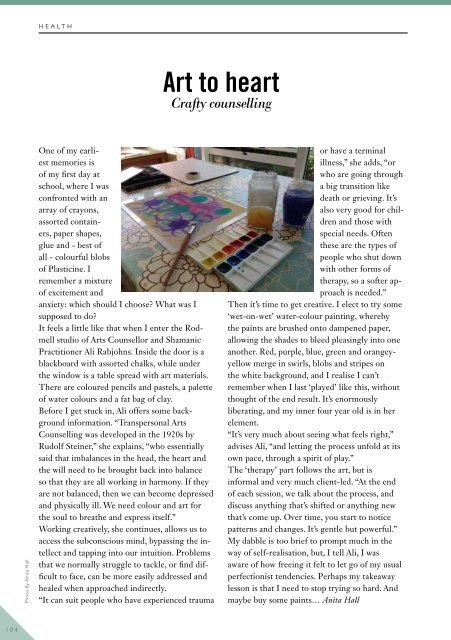Create successful ePaper yourself
Turn your PDF publications into a flip-book with our unique Google optimized e-Paper software.
HEALTH<br />
Art to heart<br />
Crafty counselling<br />
Photo by Anita Hall<br />
One of my earliest<br />
memories is<br />
of my first day at<br />
school, where I was<br />
confronted with an<br />
array of crayons,<br />
assorted containers,<br />
paper shapes,<br />
glue and - best of<br />
all - colourful blobs<br />
of Plasticine. I<br />
remember a mixture<br />
of excitement and<br />
anxiety: which should I choose? What was I<br />
supposed to do?<br />
It feels a little like that when I enter the Rodmell<br />
studio of Arts Counsellor and Shamanic<br />
Practitioner Ali Rabjohns. Inside the door is a<br />
blackboard with assorted chalks, while under<br />
the window is a table spread with art materials.<br />
There are coloured pencils and pastels, a palette<br />
of water colours and a fat bag of clay.<br />
Before I get stuck in, Ali offers some background<br />
information. “Transpersonal Arts<br />
Counselling was developed in the 1920s by<br />
Rudolf Steiner,” she explains, “who essentially<br />
said that imbalances in the head, the heart and<br />
the will need to be brought back into balance<br />
so that they are all working in harmony. If they<br />
are not balanced, then we can become depressed<br />
and physically ill. We need colour and art for<br />
the soul to breathe and express itself.”<br />
Working creatively, she continues, allows us to<br />
access the subconscious mind, bypassing the intellect<br />
and tapping into our intuition. Problems<br />
that we normally struggle to tackle, or find difficult<br />
to face, can be more easily addressed and<br />
healed when approached indirectly.<br />
“It can suit people who have experienced trauma<br />
or have a terminal<br />
illness,” she adds, “or<br />
who are going through<br />
a big transition like<br />
death or grieving. It’s<br />
also very good for children<br />
and those with<br />
special needs. Often<br />
these are the types of<br />
people who shut down<br />
with other forms of<br />
therapy, so a softer approach<br />
is needed.”<br />
Then it’s time to get creative. I elect to try some<br />
‘wet-on-wet’ water-colour painting, whereby<br />
the paints are brushed onto dampened paper,<br />
allowing the shades to bleed pleasingly into one<br />
another. Red, purple, blue, green and orangeyyellow<br />
merge in swirls, blobs and stripes on<br />
the white background, and I realise I can’t<br />
remember when I last ‘played’ like this, without<br />
thought of the end result. It’s enormously<br />
liberating, and my inner four year old is in her<br />
element.<br />
“It’s very much about seeing what feels right,”<br />
advises Ali, “and letting the process unfold at its<br />
own pace, through a spirit of play.”<br />
The ‘therapy’ part follows the art, but is<br />
informal and very much client-led. “At the end<br />
of each session, we talk about the process, and<br />
discuss anything that’s shifted or anything new<br />
that’s come up. Over time, you start to notice<br />
patterns and changes. It’s gentle but powerful.”<br />
My dabble is too brief to prompt much in the<br />
way of self-realisation, but, I tell Ali, I was<br />
aware of how freeing it felt to let go of my usual<br />
perfectionist tendencies. Perhaps my takeaway<br />
lesson is that I need to stop trying so hard. And<br />
maybe buy some paints… Anita Hall<br />
104


















